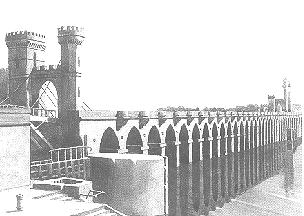Samir Raafat
Cairo Times, August 21, 1997

photo discovered in an album of Judith MacBeth's father. Presumably
it was taken some time during the time he served in the RAF in Egypt for 5 years
until Dec 1934. (hmacbeth@tiscali.co.uk)

|
|
|
|
|
Cheers to our "talented" literature prize awardee. Your pain his gain !!!
|
|
|
EGY.COM - LANDMARKS - CAIRO - HELIOPOLIS
|
|
Samir Raafat
Cairo Times, August 21, 1997

photo discovered in an album of Judith MacBeth's father. Presumably
it was taken some time during the time he served in the RAF in Egypt for 5 years
until Dec 1934. (hmacbeth@tiscali.co.uk)

Except for historians and Nilobuffs, few have heard of the Mougel Bey. The Frenchman's claim to fame is that he was the first one to harness the Nile on paper when with the encouragement of Mohammed Ali, founder of the dynasty that ruled Egypt from 1805 to 1952, he drew up the first plans for the construction of a barrage at a point where the world's longest, south-north flowing river splits into two branches, the Rosette and the Damiette. Yet, because of perennial money problems, Mougel did not live long enough to see his blueprint completed save for the laying of part of the foundation in 1833.
According to American diplomat Edwin de Leon, author of The Khedive's People, Mohammed Ali's grandson Abbas would have allegedly sacrificed one of the pyramids for the sake of saving on the cost of completing the dam. When his suggestion met with absolute indignation, Abbas reprimanded his engineer. "Why not? Are you silly enough to attach any reverence to these ugly, useless piles of stone? See if you cannot make use of them for the barrage."
The pyramid was saved from the despot's benightedness when the French engineer, who having shuddered at the thought of entering posterity as the man who dismantled one of the seven ancient wonders of the world, presented Abbas with prohibitive costs for the project. The sudden death of Abbas also helped some.
When Viceroy Sa•d Pasha took over the project he ordered a silver medal to be struck to mark the occasion. He then ordered the construction of a town near the incomplete barrage. Yet, once again the project was bogged down because of financial problems.
By the time the barrage was finally completed in 1862, during the early reign of Viceroy Ismail Pasha's (not yet upgraded to khedive of Egypt), three million pounds had been spent already. The Rosette section was 465 meters in length with 61 arches of 4.8 meters in length each. The Damiett section was 545 meters long and had a similar number of arches and locks. When it was time to operate the dam, the foundations had been so poorly laid that the whole purpose for which it had been built in the first place was abandoned. The Delta barrage was a white elephant. In reality it had become one of the most expensive bridges on the Nile!
A project presented by British engineer John Fowler for the strengthening of the Barrages' foundations was abandoned by the government. The task of finding a long term solution was given to the head of the irrigation department, Sir Colin Scott Montcrieff, whose name is remembered today in chic quarters of Cairo not as the director of Egypt's first Irrigation Department, but as the former name of a Zamalek Street (today, Sharia al-Mansour Mohammed).
In 1893, Scott asked Sir William Willcocks to explore the best way to re-transform the maligned bridge into a barrage. At first, Willcocks used rudimentary items to plug in the leaking barrage gates such as furniture in an abandoned nearby khedivial resthouse. It worked and the cotton crop of 1894 was saved in the Delta! And where it had not been seen for years except in high floods, water appeared in abundance and was available as late as the middle of June.
The following year the Irrigation Department requested a hefty loan for the serious rehabilitation of the barrage without which nothing sustainable could be done. The sum requested at the time was half a million pounds.
Five years later, on June 15, 1890, the foundation-strengthening work, all of it below water level, was declared complete. Likewise, the sluice gates were greatly improved so that the Delta Barrage could now hold up to 4 meters head of water which led to the unparalleled control of water levels in Lower Egypt. The overall effects were altogether unexpected and startling. The most important among them being the reduction in costs of lifting water to irrigate fields; the abolishment of the corvée (forced labor without remuneration) system needed to unplug the canals from its silt; the doubling of the cotton crop; and the halving of costs needed to raising crops in general. All of these factors combined stimulated a demand for land which saw a doubling in price and which could not immediately be satisfied.
"Better safe than sorry." was the vote passed by the irrigation pundits when the motion for a larger, higher and stronger barrage was put forward in the 1930s. The old barrage was leaking again and the expenses required to redeem this precarious situation were of such magnitude that the building of a new one was more feasible.
The building of the new Mohammed Ali Barrage was awarded through public tender to the British firm of Messrs. McDonald Gibbs & Co. (Engineers) and was inaugurated in December 1939. Thanks to technological advances its the foundation were built in steel piling and concrete cement encrusted several meters below the sandy base. Granite from Aswan was also used for part of the body. The entire works required a work force of twelve thousand and cost 2.75 million pounds. The new construction was a great success.
The nearby old Delta Barrage, which very nearly cost Egypt one of its Giza pyramids, could once again be relegated to the status of a romantic river crossing.
|
|
|
|